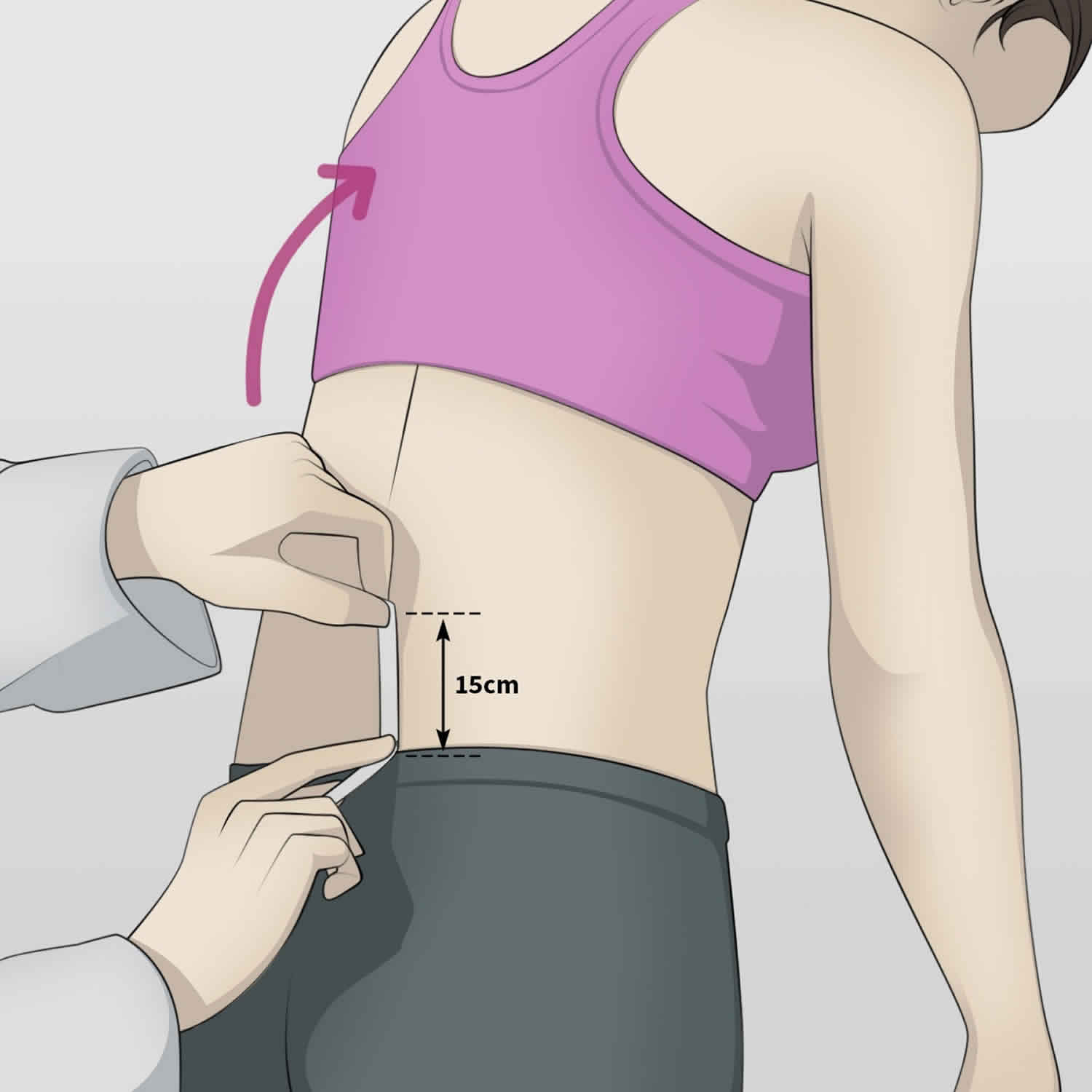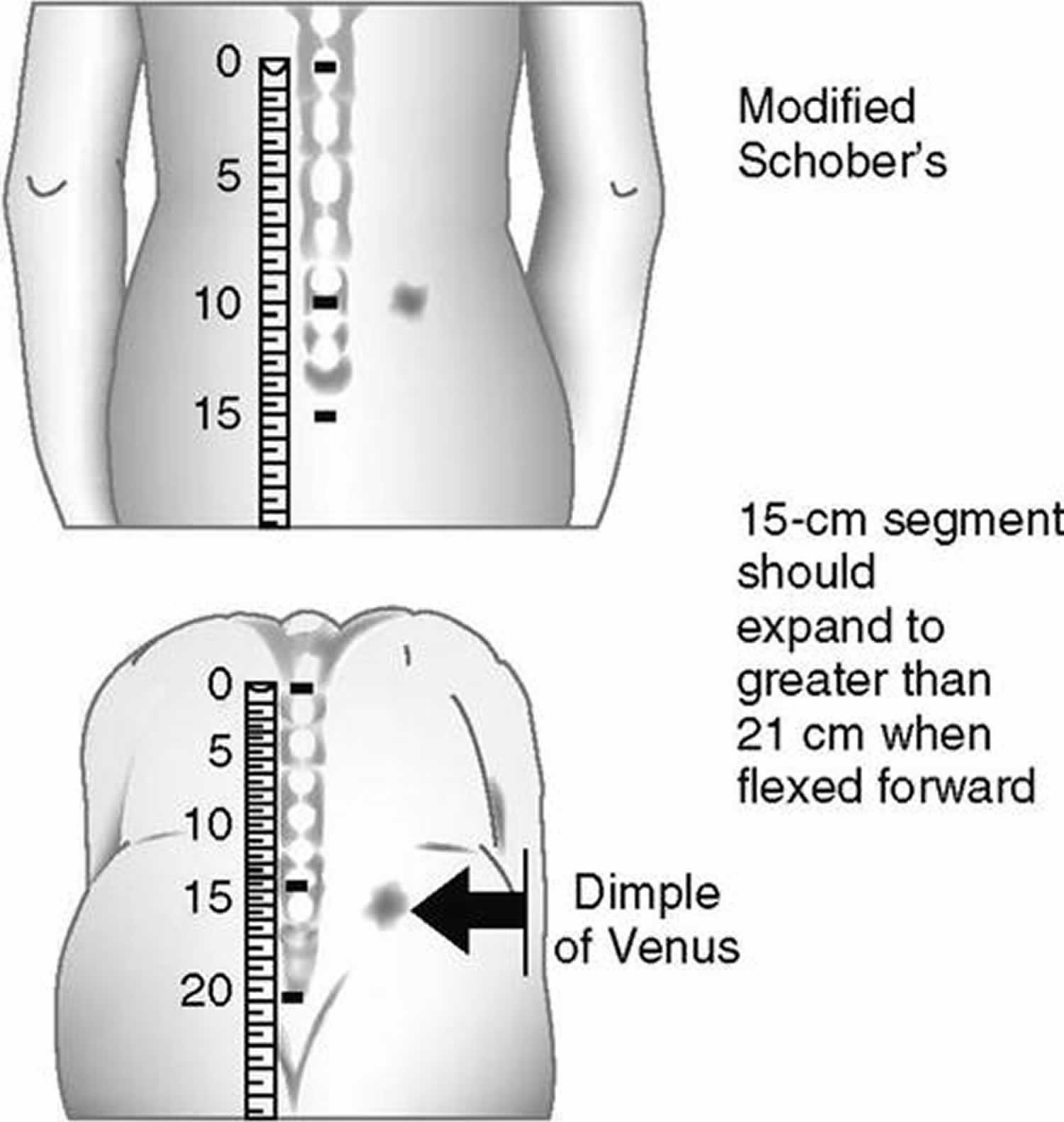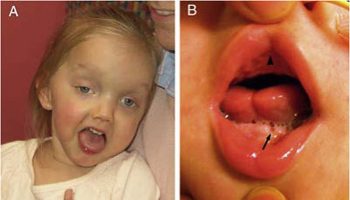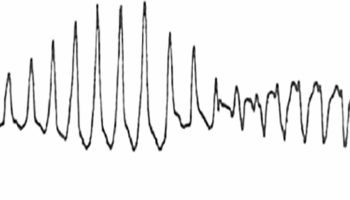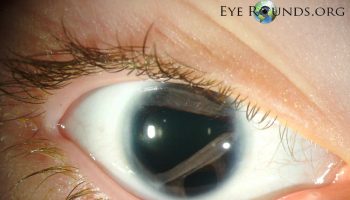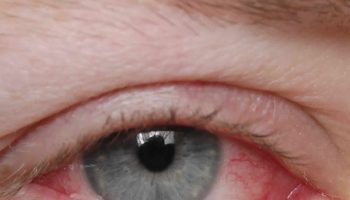Schober test
Schober test is is a physical examination used in rehabilitation, rheumatology and orthopedic clinical practice to measure the ability of a patient to flex his/her lower back to determine if there is decrease in lumbar range of motion (ROM) 1. The measurements of lower back is necessary in assessment of lower back pain and for those who has ankylosing spondylitis. The measurement of Schober test is not only useful for screening the status of ankylosing spondylitis disease but also useful for the determination of progression and therapeutic effects of ankylosing spondylitis 2 as well as other pathologic conditions associated with low back pain 3. Schober’s test results are partitioned into original Schober test, modified Schober test (Modified Schober Index) and modified-modified Schober test 4. Despite excellent intrarater reliabilities for original Schober test, modified Schober test and modified-modified Schober test, only a weak correlation could be established between original Schober test, modified Schober test and modified-modified Schober test and radiographical analysis 4. Modified-modified Schober test was found not to reflect lumbar spine angular motions. Although modified Schober test reflected spinal mobility better than original Schober test, both seemed to reflect lumbar spine angular motion poorly 4.
The original Schober test declined with age from 5.0 cm in the youngest (20–30 years old) to 3.1 cm in the aged (70–80 years old) male subjects and from 3.6 cm to 2.4 cm in the female subjects 5. The male original Schober test was significantly more than the female original Schober test. There was a good correlation between original Schober test and modified Schober test in each of the three age groups of both sexes 5.
Figure 1. Schober test
Original Schober test
The patient is standing with his back towards the examiner. The examiner determines the location of the lumbosacral junction and marks it by drawing a horizontal line. A second line is marked 10 cm above the first line. The difference between the measurements in erect and flexion positions indicates the outcome of the lumbar flexion 1.
Schober test interpretation
The validity against radiographs was according to Macrae strong (r=0.90), according to Rahali-Khachlouf moderate (r=0.68). The interclass (r=0.90) and intraclass (r=0.96) reliability was found to be excellent 1.
Modified Schober test
Modified Schober test also called short Schober test or Modified Schober Index is used to measure the range of motion of lumbar flexion 6.
Modified Schober test (Modified Schober Index) technique
The patient is standing with his back towards the examiner. The examiner determines the location of the lumbosacral junction at the level of the posterior superior iliac spine by pressing the location of the dimples of Venus. The intersection of the top of the dimples of Venus is marked by drawing a horizontal line. This line acts as the landmark. Two other marks will be drawn 10 cm above and 5 cm below the first landmark. The patient will then be asked to bend over and touch his or her toes as long as possible without increasing pain. The examiner will measure the increase in distance between the superior and inferior marks. The length increment, which is the difference between the 15-cm distance (neutral position) and the increased distance (anterior flexion posture), will be calculated to determine the range of motion of the lumbar spine.
Modified Schober test interpretation
The validity against radiographs was according to Macrae. strong (r=0.97), according to Rahali-Khachlouf. moderate (r=0.59). The interclass (r=0.92) and intraclass (r=0.96) reliability were found to be excellent 7.
Figure 2. Modified Schober test
Modified-modified Schober test
Modified Modified Schober Test is a modification of the Modified Schober Test by Van Adrichen and Van der Korst 8. The patient is standing with his back towards the examiner. The examiner locates the inferior margin of the posterior superior iliac spine with the thumbs and then marks the intersections of the posterior superior iliac spine by drawing a horizontal line. The second line is drawn 15 cm above the midpoint of the first horizontal line. The difference between the measurements in erect and flexion positions indicates the outcome of the lumbar flexion 1. It eliminates the errors in identification of lumbosacral junction and makes sure that the entire lumbar spine was included.
Figure 3. Modified Modified Schober Test
Footnote: Landmarks (a): X represents the spinal intersection of a horizontal line between the left and right posterior superior iliac spines, and Y is the point 15 cm above X. Measurements of flexion (b) and extension (c).
[Source 9 ]Modified-modified Schober test interpretation
The validity of the modified-modified Schober test is moderate (r=0.67) with an excellent interclass (r=0.91) and intraclass (r=95) reliability 1.
- Rezvani A, Ergin O., Karacan I., Validity and reliability of the Metric Measurements in the Assessment of Lumbar Spine Motion in patients with Ankylosing Spondylitis., 2012, Lippincott Williams & Wilkins, SPINE vol 37, Number 19, pp E1189-E1196[↩][↩][↩][↩][↩]
- Viitanen J. V., Suni J., Kautiainen H., Liimatainen M., Takala H. Effect of physiotherapy on spinal mobility in ankylosing spondylitis. Scandinavian Journal of Rheumatology. 1992;21(1):38–41. doi: 10.3109/03009749209095061[↩]
- Cho H., Kim T., Kim T.-H., Lee S., Lee K. H. Spinal mobility, vertebral squaring, pulmonary function, pain, fatigue, and quality of life in patients with ankylosing spondylitis. Annals of Rehabilitation Medicine. 2013;37(5):675–682. doi: 10.5535/arm.2013.37.5.675[↩]
- Rezvani A., Ergin O., Karacan I., Oncu M. Validity and reliability of the metric measurements in the assessment of lumbar spine motion in patients with ankylosing spondylitis. Spine (Phila Pa 1976). 2012 Sep 1;37(19):E1189-96. doi: 10.1097/BRS.0b013e31825ef954.[↩][↩][↩]
- Yong-Ren Yen, Jin-Fan Luo, Ming-Li Liu, Fung-Jou Lu, and Soo-Ray Wang, “The Anthropometric Measurement of Schober’s Test in Normal Taiwanese Population,” BioMed Research International, vol. 2015, Article ID 256365, 5 pages, 2015. https://doi.org/10.1155/2015/256365[↩][↩]
- Tousignant M., Poulin L., Marchand S., Viau A., Place C. The Modified-Modified Schober Test for range of motion assessment of lumbar flexion in patients with low back pain: a study of criterion validity, intra- and inter-rater reliability and minimum metrically detectable change. Disabil Rehabil. 2005;27:553–559. https://doi.org/10.1080/09638280400018411[↩]
- M Tousignant, Poulin L, Marchand S, , the modified-modified schober test for range of motion assessment of lumbar flexion in patients with low back pain: a study of criterion validity, intra- and inter-rater reliability and minimum metrically detectable change, disability and rehabilitation, 2005, VOL.27, NO.10, Pages 553-559[↩]
- Tousignant M, Poulin L, Marchand S, Viau A, Place C. The Modified–Modified Schober Test for range of motion assessment of lumbar flexion in patients with low back pain: A study of criterion validity, intra-and inter-rater reliability and minimum metrically detectable change. Disability and rehabilitation. 2005 May 20;27(10):553-9.[↩]
- Chatchawan, Uraiwan & Jupamatangb, Unthika & Chanchitc, Sunisa & Puntumetakul, Rungthip & Donpunha, Wanida & Yamauchi, Junichiro. (2015). Immediate effects of dynamic sitting exercise on the lower back mobility of sedentary young adults. Journal of Physical Therapy Science. 27. 3359-3363. 10.1589/jpts.27.3359. [↩]
